|
|
As in all Greco/Roman myths, there are variations in the storyline depending upon which source you reference. The Perseus story involves six Ptolemaic constellations.
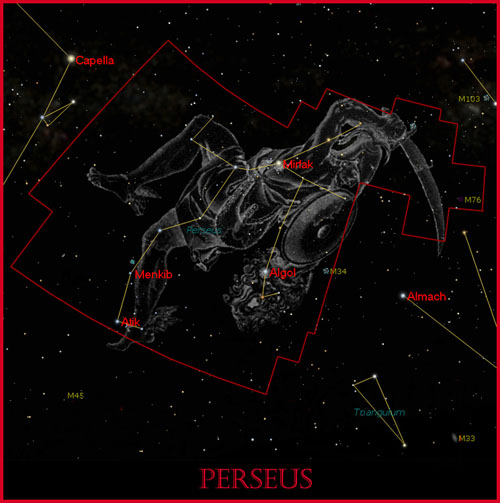
|
Perseus (PURR-se-us) was the son of Zeus & Danaë (dan’ a-e). His mother had been locked up in a tower with bronze doors by her father Acrisius, King of Argos, because had been terrified by an oracle indicating her son would cause his death. It had been prophesized to Acrisius that he would have no sons as heir to his kingdom but a grandson would be brought into the world that would end his life. Being in a tower didn’t prevent that rascal Zeus from seeing Danaë and of course her beauty intrigued him. So he had his way with her by turning into a shower of golden rain that entered her place of captivity. Acrisius was horrified and perplexed about this event; he didn’t believe for a minute Zeus was responsible as his daughter indicated. He didn’t have overly strong fatherly affection in any event and would have put mother and child to death except for fear of godly retribution. The gods took a dim view of spilling kindred blood it seems. Besides, she may have been telling the truth about the entire Zeus episode…So Perseus came into the world safely. Acrisius decided to get rid of the pair without actually having them killed by his hand, so placed them in a chest (or wooden ark) and launched it out to sea. They floated near the island of Seriphos still alive and under the protection of Zeus, where they were discovered by a kindly fisherman named Dictys, who happened to be the brother of the local king, Polydectes (Polydec’ tes). Polydectes figured there must be something special about the pair and raised Perseus to manhood on his estate. He desired to make the still lovely Danaë his wife and didn’t care to have Perseus as part of the deal. He tried to force Danaë into marriage but Perseus was able prevent the union, much to the chagrin of Polydectes. He decided to try something new and devious to circumvent the impediment of Perseus. Polydectes announced his intention to marry another and asked his friends and supporters, including Perseus, for a gift of a horse each as a betrothal bequest. (Note that another version of this myth indicates Polydectes’ plan was to raise a tax of horses on the islanders – either tale had the same effect on our hero). He knew Perseus didn’t have anything to offer and was quite prideful so was working that angle, which quickly came to fruition. Perseus was so pleased that his mother was out of marriage contention but so mortified he couldn’t provide a horse, he told Polydectes that he would contrive to win any gift he may choose. Polydectes accepted this offer at once and asked him to fetch the head of the Gorgon Medusa, a creature with snakes in lieu of hair and so hideous that the sight of her would turn a living creature to stone. |
|
Some background on Medusa (‘ruler or queen’) is helpful here:
Medusa (‘ruler or queen’) began life as a beautiful maiden and had the unfortunate circumstance to be noticed by Poseidon (Neptune), who, thinking she was
pretty hot, pursued her. Eventually Poseidon was able to seduce Medusa and to her misfortune, did so in a temple dedicated to Athena (Minerva). The
goddess was already jealous of Medusa’s beauty and this affront to her temple was just too much, so Medusa she transformed into a Gorgon. Having started
out as a woman, she was mortal unlike her two sisters, Steheno (‘strength’) & Euryale (‘wide-leaping’).
Athena overheard this discussion and still incensed about the sacrilege perpetrated in her temple, hated Medusa and decided to aid Perseus in his quest. She appeared to him and informed Perseus how to go about the task at hand, presenting him a polished shield to prevent having to look at the Gorgon directly. She also indicated she would enlist help from Hermes (Mercury – also a son of Zeus) in his travels and travails. He first had to collect some articles to complete the quest and informed on what he must do & where he must go, went on his way to seek the Graiae guided by Hermes and Athena. The Graiae were three old hag sisters with swanlike bodies and human heads living in the mountains. They knew where to find the Stygian Nymphs, keepers of the other items Perseus required including a pair of winged sandals, a wallet (that would instantly transform in size to whatever was placed in it) and a helmet that rendered the wearer invisible, all owned by Hades and in the Nymphs’ care. The Graiae shared an eye and tooth between them that they circulated to see and eat. These hags weren’t especially nice or helpful and would only offer information if forced to do so. Upon finding their haunt, Perseus as directed by Athena, waited until the sisters were making an exchange of the eye and snatched it from them. He indicated he’d give it back only if they informed him where he could find the Nymphs, which they quickly did. Perseus found the Stygian Nymphs, collected the goods and was on his way to locate the Gorgons. Some accounts indicate Hermes talked with him along the way to help and guide him and gave him a sickle of adamantine (an unbreakable material) or curved sword and perhaps even the winged shoes along with a flight lesson. |
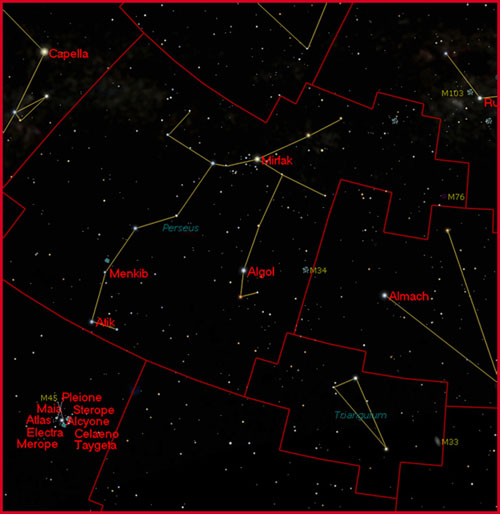
|

|
Flying to the haunt of the Gorgons, Perseus, made invisible by Hades helmet made a stealthy approach being certain to avoid the two immortal Gorgon sisters. Using the reflection in the shield provided by Athena to avoid looking upon Medusa he advanced and with his hand guided by Athena, whacked off her head with one mighty blow. Much to his surprise, the winged-horse Pegasus and his brother, the warrior Chrysaor, sprang fully grown from her dead body… Perseus stashed the head in the wallet to keep it from his view and avoiding the wrath of the two remaining Gorgon sisters due to his invisible state, off he went. Ovid’s account indicates Perseus used the Medusa’s head to turn the Titan Atlas to stone due to his inhospitality. Atlas became a vast mountain on which the sky rested for all time, although this account of Atlas conflicts with others. |
|
Some background on Andromeda and family: Andromeda was the daughter of Cepheus, Ethiopian King of Joppa (not the Ethiopia we think of today) and Queen Cassiopeia. Cassiopeia had the bad sense to boast she and her daughter were more beautiful than the Nereids (Nymphs of the sea, there were fifty of them), who caught wind of this and complained to their protector, Poseidon (Neptune). Poseidon took action and sent a flood followed by a sea monster (claimed by some accounts to be Cetus of constellation fame & assumed so for this account) to destroy their city. Cepheus, realizing he had to do something, consulted the Oracle of Ammon, where he was informed that his only hope lay in sacrificing his daughter Andromeda to the beast, which he dutifully decided to do as the best course of action. The account picks up from there: Perseus continued his flight heading home to momma and came upon a beautiful woman chained buck-naked to a rock, her jewels gleaming in the sun. Yes, she was naked except for her jewelry… As is the case in many Greek myths, he was smitten by her and fell instantly in love. Spotting Cepheus and Cassiopeia watching events unfold at distance from the chained Andromeda, flew over to find out what the deal was. After some discussion, it was determined that if Perseus could rid them of the monster they would agree to his marriage to Andromeda and allow her to go with him back to Greece. |
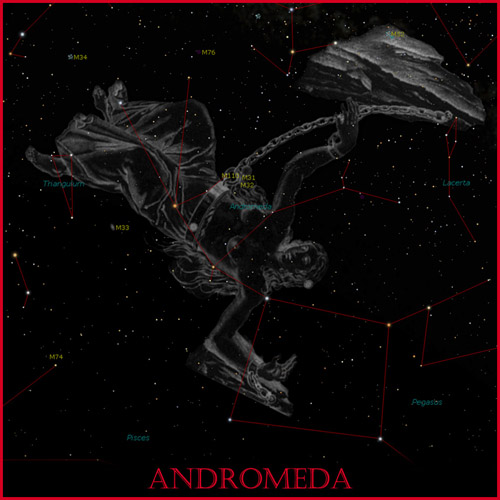
|
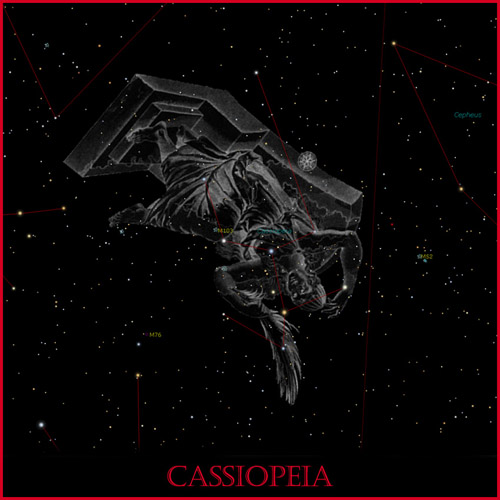
|
Perseus waited for the sea monster and when she appeared, attacked and slew the beast with the sword Hermes had given him. (Note – some accounts indicate he turned Cetus to stone with Medusa’s head). Perseus having saved the princess gathered her up and told the prospective in-laws to prepare the wedding feast. They grudgingly welcomed him into the fold and at Andromeda’s insistence the wedding took place at once. However, these parents weren’t quite done yet as they wished to renege on the marriage proposal, probably thinking that Perseus wasn’t good enough for their daughter and they could make a much better political union. So during the wedding feast Cassiopeia had Phineus, the King’s brother and Andromeda’s former betrothed (note some accounts indicate this man as Agenor although the premise is much the same) show up to claim Andromeda as his own and to get rid of Perseus once and for all. The point is that Cepheus and Cassiopeia had broken faith almost immediately with their promise. Phineus was escorted by his followers and prepared for battle. He quickly attacked Perseus with every intention of taking his life. Perseus, rising to the occasion, fought valiantly but was greatly outnumbered and knew he couldn’t slay all his attackers unaided. He did have however, one of the greatest weapons of mass destruction in the ancient world at hand. He jerked Medusa’s head out of the wallet and turned the remaining two-hundred warriors to stone, ending the day in complete victory. Andromeda and Perseus remained happily married and the union produced six sons. Now how’s that for a happy ending…. |
|
Accounts differ about who placed their constellations in the sky. Some indicate Poseidon placed the dishonored Cassiopeia and Cepheus in the heavens as a punishment for their conniving ways with both circling the pole star while vain Cassiopeia combs her hair for eternity. He also placed Cetus, his sea monster in the heavens as a reward for the creature’s service to him. Other accounts indicate Athena placed all of them in the sky as constellations. Perseus, Pegasus, Andromeda, Cetus, Cassiopeia and Cepheus would forever serve as lessons, good and bad for earthbound mortals in their common tale. |
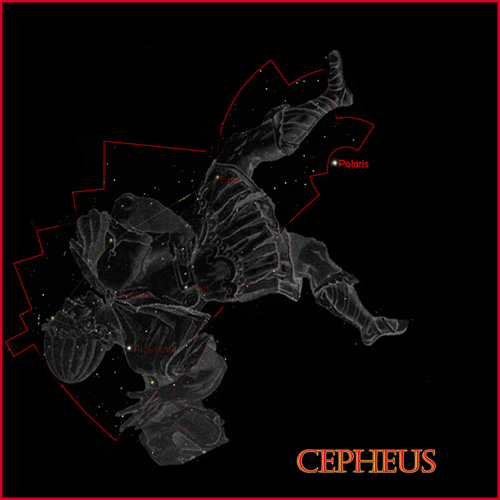
|
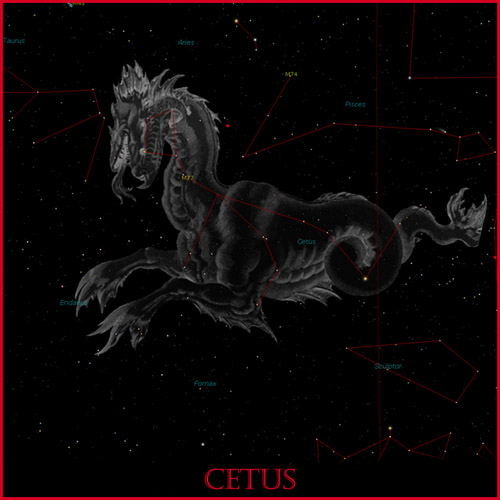
|
Perseus returned hurriedly to Seriphos where he learned his mother and Dictys had taken refuge and were living in fear in a temple after being threatened repeatedly by Polydectes. Without delay Perseus headed to confront Polydectes who was hosting a banquet when he arrived and announced completion of his quest. He was greeted with jeers, derision and a storm of insults. Seeing where this was leading, he decided to show all in the hall his gift to Polydectes – he yanked Medusa’s head out of the wallet and turned the entire entourage to stone; thus ended the persecution of Danaë by Polydectes. With the task at hand completed, Athena left him with instructions to return his weapons to Hermes, who would return them to the rightful owners. Perseus left Dictys as the king of Seriphos and returned to Argos, the land of his grandfather, Acrisius. Acrisius heard of his coming and fearing fulfillment of the prophesy fled to Thessaly to avoid their meeting. By coincidence, Perseus heard of some games being held in Thessaly and also traveled there to take part. While Perseus was hurling a discus which went awry, his grandfather watching from the crowd was struck and killed proving the oracle correct. In the days of ancient Greece, you just didn’t fool around with fate… |
Classical mythological figures & star chart used in this account excerpted from TheSky 6 by Software Bisque.
Kiro
February 2007
Home